Advancements in Forensic Science and Investigation
VerifiedAdded on 2021/04/21
|9
|2483
|388
AI Summary
This assignment delves into the history of forensic science, highlighting key developments such as fingerprint analysis and DNA profiling. It discusses how these advancements have revolutionized criminal investigations, yet notes that some crimes remain unsolved despite technological progress.
Contribute Materials
Your contribution can guide someone’s learning journey. Share your
documents today.

qwertyuiopasdfghjklzxcvbnmqwertyui
opasdfghjklzxcvbnmqwertyuiopasdfgh
jklzxcvbnmqwertyuiopasdfghjklzxcvb
nmqwertyuiopasdfghjklzxcvbnmqwer
tyuiopasdfghjklzxcvbnmqwertyuiopas
dfghjklzxcvbnmqwertyuiopasdfghjklzx
cvbnmqwertyuiopasdfghjklzxcvbnmq
wertyuiopasdfghjklzxcvbnmqwertyuio
pasdfghjklzxcvbnmqwertyuiopasdfghj
Crime Scene Investigation
How the investigation of major crimes has changed in the UK in the
last 50 years?
10-Mar-18
(Student Details: )
opasdfghjklzxcvbnmqwertyuiopasdfgh
jklzxcvbnmqwertyuiopasdfghjklzxcvb
nmqwertyuiopasdfghjklzxcvbnmqwer
tyuiopasdfghjklzxcvbnmqwertyuiopas
dfghjklzxcvbnmqwertyuiopasdfghjklzx
cvbnmqwertyuiopasdfghjklzxcvbnmq
wertyuiopasdfghjklzxcvbnmqwertyuio
pasdfghjklzxcvbnmqwertyuiopasdfghj
Crime Scene Investigation
How the investigation of major crimes has changed in the UK in the
last 50 years?
10-Mar-18
(Student Details: )
Secure Best Marks with AI Grader
Need help grading? Try our AI Grader for instant feedback on your assignments.
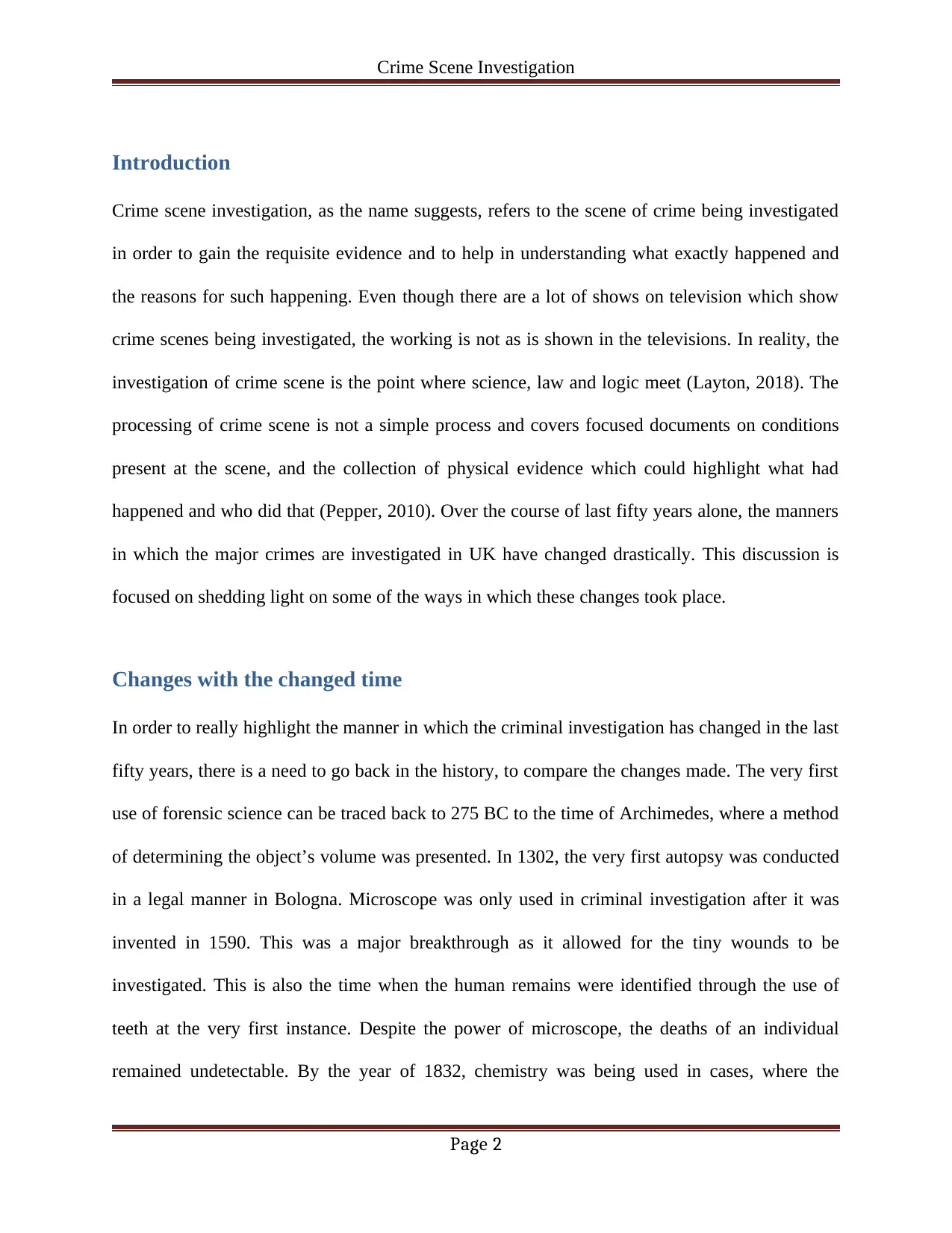
Crime Scene Investigation
Introduction
Crime scene investigation, as the name suggests, refers to the scene of crime being investigated
in order to gain the requisite evidence and to help in understanding what exactly happened and
the reasons for such happening. Even though there are a lot of shows on television which show
crime scenes being investigated, the working is not as is shown in the televisions. In reality, the
investigation of crime scene is the point where science, law and logic meet (Layton, 2018). The
processing of crime scene is not a simple process and covers focused documents on conditions
present at the scene, and the collection of physical evidence which could highlight what had
happened and who did that (Pepper, 2010). Over the course of last fifty years alone, the manners
in which the major crimes are investigated in UK have changed drastically. This discussion is
focused on shedding light on some of the ways in which these changes took place.
Changes with the changed time
In order to really highlight the manner in which the criminal investigation has changed in the last
fifty years, there is a need to go back in the history, to compare the changes made. The very first
use of forensic science can be traced back to 275 BC to the time of Archimedes, where a method
of determining the object’s volume was presented. In 1302, the very first autopsy was conducted
in a legal manner in Bologna. Microscope was only used in criminal investigation after it was
invented in 1590. This was a major breakthrough as it allowed for the tiny wounds to be
investigated. This is also the time when the human remains were identified through the use of
teeth at the very first instance. Despite the power of microscope, the deaths of an individual
remained undetectable. By the year of 1832, chemistry was being used in cases, where the
Page 2
Introduction
Crime scene investigation, as the name suggests, refers to the scene of crime being investigated
in order to gain the requisite evidence and to help in understanding what exactly happened and
the reasons for such happening. Even though there are a lot of shows on television which show
crime scenes being investigated, the working is not as is shown in the televisions. In reality, the
investigation of crime scene is the point where science, law and logic meet (Layton, 2018). The
processing of crime scene is not a simple process and covers focused documents on conditions
present at the scene, and the collection of physical evidence which could highlight what had
happened and who did that (Pepper, 2010). Over the course of last fifty years alone, the manners
in which the major crimes are investigated in UK have changed drastically. This discussion is
focused on shedding light on some of the ways in which these changes took place.
Changes with the changed time
In order to really highlight the manner in which the criminal investigation has changed in the last
fifty years, there is a need to go back in the history, to compare the changes made. The very first
use of forensic science can be traced back to 275 BC to the time of Archimedes, where a method
of determining the object’s volume was presented. In 1302, the very first autopsy was conducted
in a legal manner in Bologna. Microscope was only used in criminal investigation after it was
invented in 1590. This was a major breakthrough as it allowed for the tiny wounds to be
investigated. This is also the time when the human remains were identified through the use of
teeth at the very first instance. Despite the power of microscope, the deaths of an individual
remained undetectable. By the year of 1832, chemistry was being used in cases, where the
Page 2
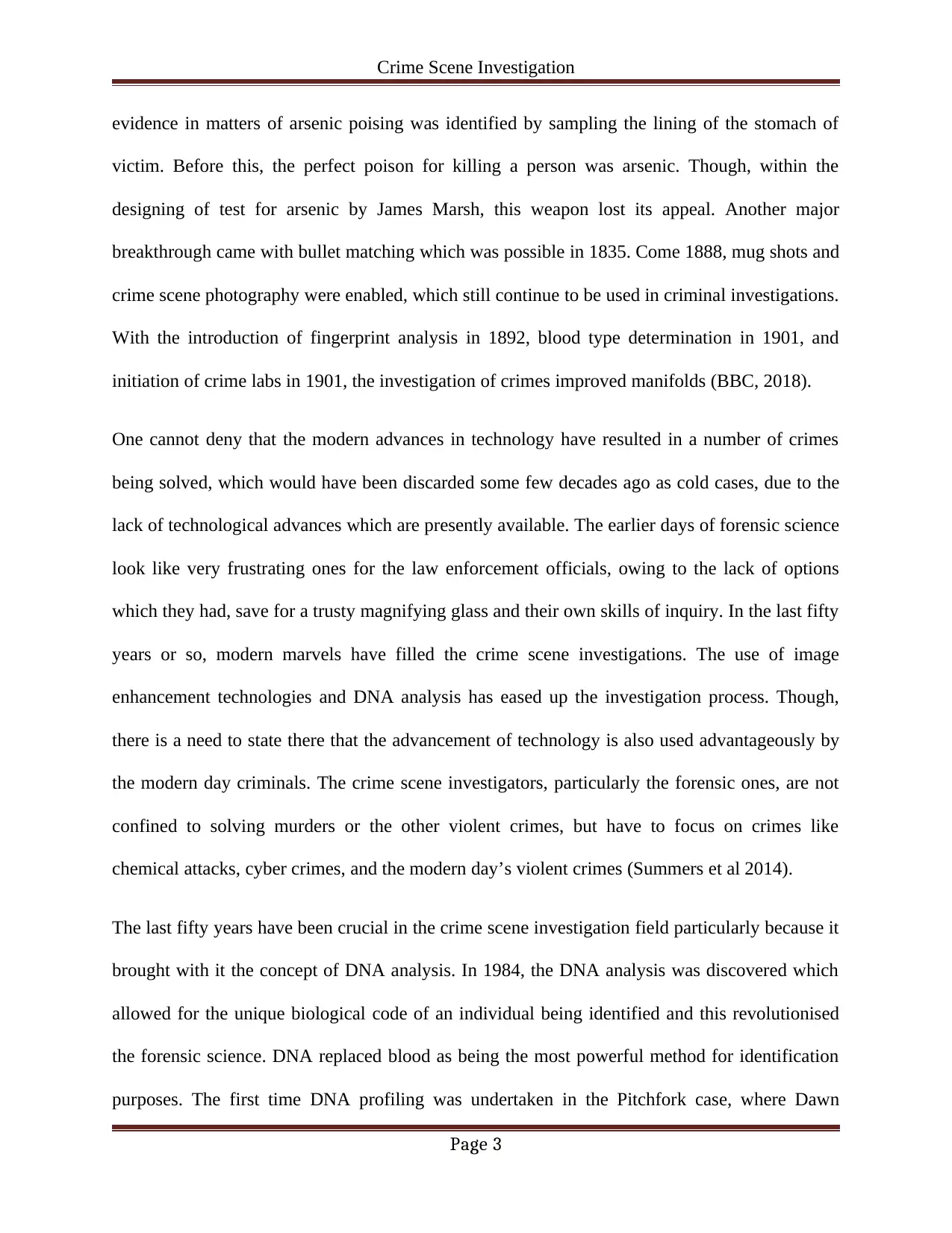
Crime Scene Investigation
evidence in matters of arsenic poising was identified by sampling the lining of the stomach of
victim. Before this, the perfect poison for killing a person was arsenic. Though, within the
designing of test for arsenic by James Marsh, this weapon lost its appeal. Another major
breakthrough came with bullet matching which was possible in 1835. Come 1888, mug shots and
crime scene photography were enabled, which still continue to be used in criminal investigations.
With the introduction of fingerprint analysis in 1892, blood type determination in 1901, and
initiation of crime labs in 1901, the investigation of crimes improved manifolds (BBC, 2018).
One cannot deny that the modern advances in technology have resulted in a number of crimes
being solved, which would have been discarded some few decades ago as cold cases, due to the
lack of technological advances which are presently available. The earlier days of forensic science
look like very frustrating ones for the law enforcement officials, owing to the lack of options
which they had, save for a trusty magnifying glass and their own skills of inquiry. In the last fifty
years or so, modern marvels have filled the crime scene investigations. The use of image
enhancement technologies and DNA analysis has eased up the investigation process. Though,
there is a need to state there that the advancement of technology is also used advantageously by
the modern day criminals. The crime scene investigators, particularly the forensic ones, are not
confined to solving murders or the other violent crimes, but have to focus on crimes like
chemical attacks, cyber crimes, and the modern day’s violent crimes (Summers et al 2014).
The last fifty years have been crucial in the crime scene investigation field particularly because it
brought with it the concept of DNA analysis. In 1984, the DNA analysis was discovered which
allowed for the unique biological code of an individual being identified and this revolutionised
the forensic science. DNA replaced blood as being the most powerful method for identification
purposes. The first time DNA profiling was undertaken in the Pitchfork case, where Dawn
Page 3
evidence in matters of arsenic poising was identified by sampling the lining of the stomach of
victim. Before this, the perfect poison for killing a person was arsenic. Though, within the
designing of test for arsenic by James Marsh, this weapon lost its appeal. Another major
breakthrough came with bullet matching which was possible in 1835. Come 1888, mug shots and
crime scene photography were enabled, which still continue to be used in criminal investigations.
With the introduction of fingerprint analysis in 1892, blood type determination in 1901, and
initiation of crime labs in 1901, the investigation of crimes improved manifolds (BBC, 2018).
One cannot deny that the modern advances in technology have resulted in a number of crimes
being solved, which would have been discarded some few decades ago as cold cases, due to the
lack of technological advances which are presently available. The earlier days of forensic science
look like very frustrating ones for the law enforcement officials, owing to the lack of options
which they had, save for a trusty magnifying glass and their own skills of inquiry. In the last fifty
years or so, modern marvels have filled the crime scene investigations. The use of image
enhancement technologies and DNA analysis has eased up the investigation process. Though,
there is a need to state there that the advancement of technology is also used advantageously by
the modern day criminals. The crime scene investigators, particularly the forensic ones, are not
confined to solving murders or the other violent crimes, but have to focus on crimes like
chemical attacks, cyber crimes, and the modern day’s violent crimes (Summers et al 2014).
The last fifty years have been crucial in the crime scene investigation field particularly because it
brought with it the concept of DNA analysis. In 1984, the DNA analysis was discovered which
allowed for the unique biological code of an individual being identified and this revolutionised
the forensic science. DNA replaced blood as being the most powerful method for identification
purposes. The first time DNA profiling was undertaken in the Pitchfork case, where Dawn
Page 3
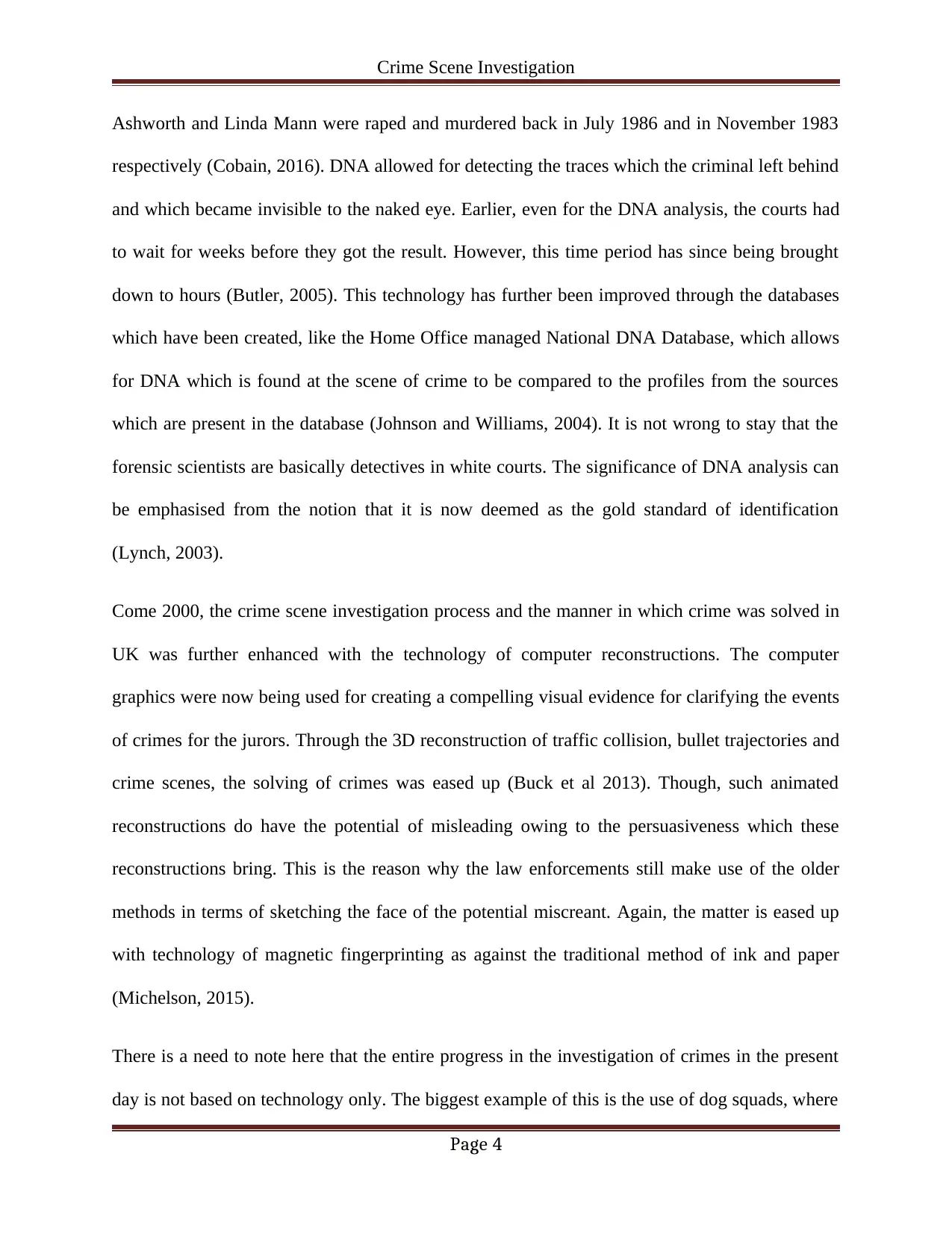
Crime Scene Investigation
Ashworth and Linda Mann were raped and murdered back in July 1986 and in November 1983
respectively (Cobain, 2016). DNA allowed for detecting the traces which the criminal left behind
and which became invisible to the naked eye. Earlier, even for the DNA analysis, the courts had
to wait for weeks before they got the result. However, this time period has since being brought
down to hours (Butler, 2005). This technology has further been improved through the databases
which have been created, like the Home Office managed National DNA Database, which allows
for DNA which is found at the scene of crime to be compared to the profiles from the sources
which are present in the database (Johnson and Williams, 2004). It is not wrong to stay that the
forensic scientists are basically detectives in white courts. The significance of DNA analysis can
be emphasised from the notion that it is now deemed as the gold standard of identification
(Lynch, 2003).
Come 2000, the crime scene investigation process and the manner in which crime was solved in
UK was further enhanced with the technology of computer reconstructions. The computer
graphics were now being used for creating a compelling visual evidence for clarifying the events
of crimes for the jurors. Through the 3D reconstruction of traffic collision, bullet trajectories and
crime scenes, the solving of crimes was eased up (Buck et al 2013). Though, such animated
reconstructions do have the potential of misleading owing to the persuasiveness which these
reconstructions bring. This is the reason why the law enforcements still make use of the older
methods in terms of sketching the face of the potential miscreant. Again, the matter is eased up
with technology of magnetic fingerprinting as against the traditional method of ink and paper
(Michelson, 2015).
There is a need to note here that the entire progress in the investigation of crimes in the present
day is not based on technology only. The biggest example of this is the use of dog squads, where
Page 4
Ashworth and Linda Mann were raped and murdered back in July 1986 and in November 1983
respectively (Cobain, 2016). DNA allowed for detecting the traces which the criminal left behind
and which became invisible to the naked eye. Earlier, even for the DNA analysis, the courts had
to wait for weeks before they got the result. However, this time period has since being brought
down to hours (Butler, 2005). This technology has further been improved through the databases
which have been created, like the Home Office managed National DNA Database, which allows
for DNA which is found at the scene of crime to be compared to the profiles from the sources
which are present in the database (Johnson and Williams, 2004). It is not wrong to stay that the
forensic scientists are basically detectives in white courts. The significance of DNA analysis can
be emphasised from the notion that it is now deemed as the gold standard of identification
(Lynch, 2003).
Come 2000, the crime scene investigation process and the manner in which crime was solved in
UK was further enhanced with the technology of computer reconstructions. The computer
graphics were now being used for creating a compelling visual evidence for clarifying the events
of crimes for the jurors. Through the 3D reconstruction of traffic collision, bullet trajectories and
crime scenes, the solving of crimes was eased up (Buck et al 2013). Though, such animated
reconstructions do have the potential of misleading owing to the persuasiveness which these
reconstructions bring. This is the reason why the law enforcements still make use of the older
methods in terms of sketching the face of the potential miscreant. Again, the matter is eased up
with technology of magnetic fingerprinting as against the traditional method of ink and paper
(Michelson, 2015).
There is a need to note here that the entire progress in the investigation of crimes in the present
day is not based on technology only. The biggest example of this is the use of dog squads, where
Page 4
Secure Best Marks with AI Grader
Need help grading? Try our AI Grader for instant feedback on your assignments.
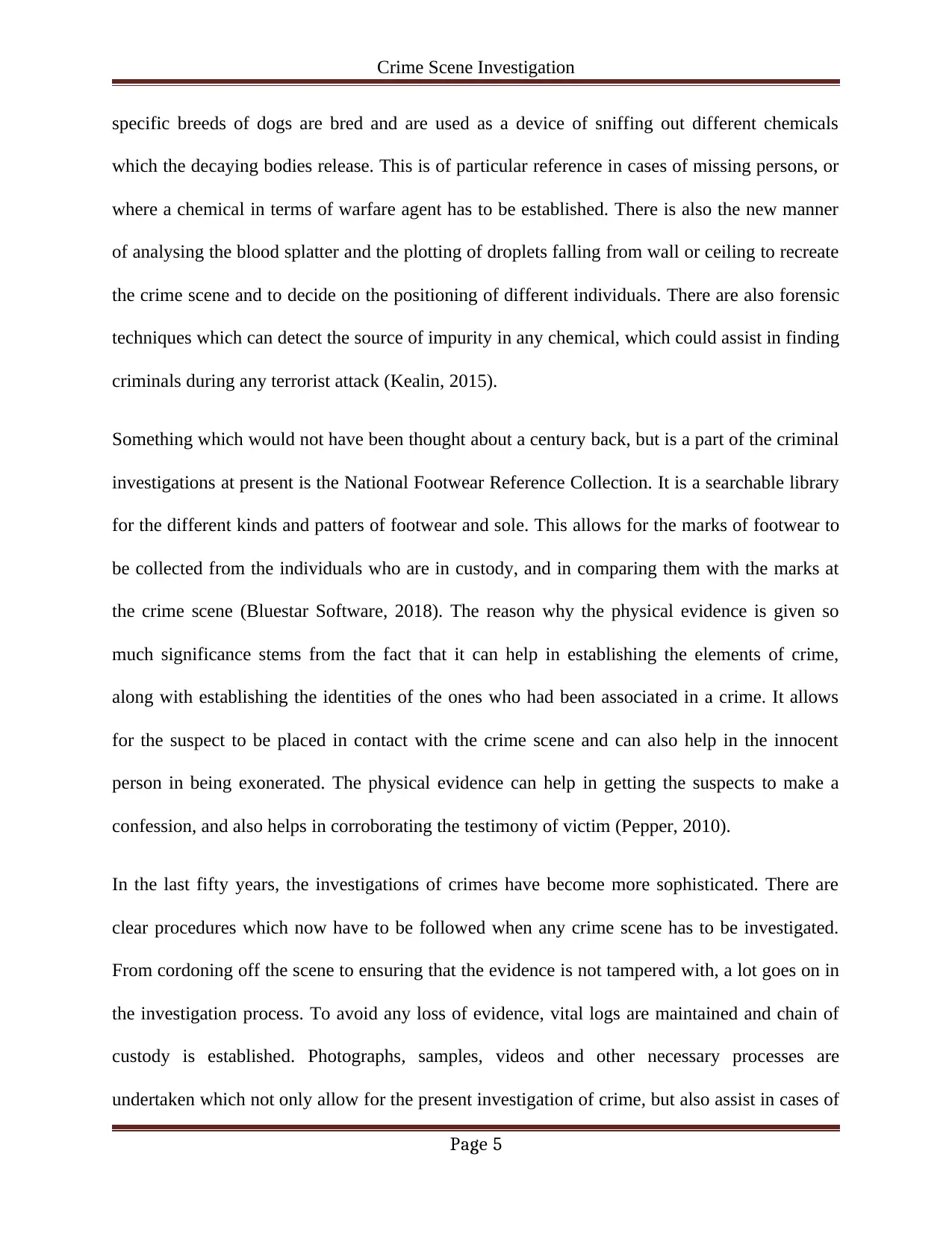
Crime Scene Investigation
specific breeds of dogs are bred and are used as a device of sniffing out different chemicals
which the decaying bodies release. This is of particular reference in cases of missing persons, or
where a chemical in terms of warfare agent has to be established. There is also the new manner
of analysing the blood splatter and the plotting of droplets falling from wall or ceiling to recreate
the crime scene and to decide on the positioning of different individuals. There are also forensic
techniques which can detect the source of impurity in any chemical, which could assist in finding
criminals during any terrorist attack (Kealin, 2015).
Something which would not have been thought about a century back, but is a part of the criminal
investigations at present is the National Footwear Reference Collection. It is a searchable library
for the different kinds and patters of footwear and sole. This allows for the marks of footwear to
be collected from the individuals who are in custody, and in comparing them with the marks at
the crime scene (Bluestar Software, 2018). The reason why the physical evidence is given so
much significance stems from the fact that it can help in establishing the elements of crime,
along with establishing the identities of the ones who had been associated in a crime. It allows
for the suspect to be placed in contact with the crime scene and can also help in the innocent
person in being exonerated. The physical evidence can help in getting the suspects to make a
confession, and also helps in corroborating the testimony of victim (Pepper, 2010).
In the last fifty years, the investigations of crimes have become more sophisticated. There are
clear procedures which now have to be followed when any crime scene has to be investigated.
From cordoning off the scene to ensuring that the evidence is not tampered with, a lot goes on in
the investigation process. To avoid any loss of evidence, vital logs are maintained and chain of
custody is established. Photographs, samples, videos and other necessary processes are
undertaken which not only allow for the present investigation of crime, but also assist in cases of
Page 5
specific breeds of dogs are bred and are used as a device of sniffing out different chemicals
which the decaying bodies release. This is of particular reference in cases of missing persons, or
where a chemical in terms of warfare agent has to be established. There is also the new manner
of analysing the blood splatter and the plotting of droplets falling from wall or ceiling to recreate
the crime scene and to decide on the positioning of different individuals. There are also forensic
techniques which can detect the source of impurity in any chemical, which could assist in finding
criminals during any terrorist attack (Kealin, 2015).
Something which would not have been thought about a century back, but is a part of the criminal
investigations at present is the National Footwear Reference Collection. It is a searchable library
for the different kinds and patters of footwear and sole. This allows for the marks of footwear to
be collected from the individuals who are in custody, and in comparing them with the marks at
the crime scene (Bluestar Software, 2018). The reason why the physical evidence is given so
much significance stems from the fact that it can help in establishing the elements of crime,
along with establishing the identities of the ones who had been associated in a crime. It allows
for the suspect to be placed in contact with the crime scene and can also help in the innocent
person in being exonerated. The physical evidence can help in getting the suspects to make a
confession, and also helps in corroborating the testimony of victim (Pepper, 2010).
In the last fifty years, the investigations of crimes have become more sophisticated. There are
clear procedures which now have to be followed when any crime scene has to be investigated.
From cordoning off the scene to ensuring that the evidence is not tampered with, a lot goes on in
the investigation process. To avoid any loss of evidence, vital logs are maintained and chain of
custody is established. Photographs, samples, videos and other necessary processes are
undertaken which not only allow for the present investigation of crime, but also assist in cases of
Page 5
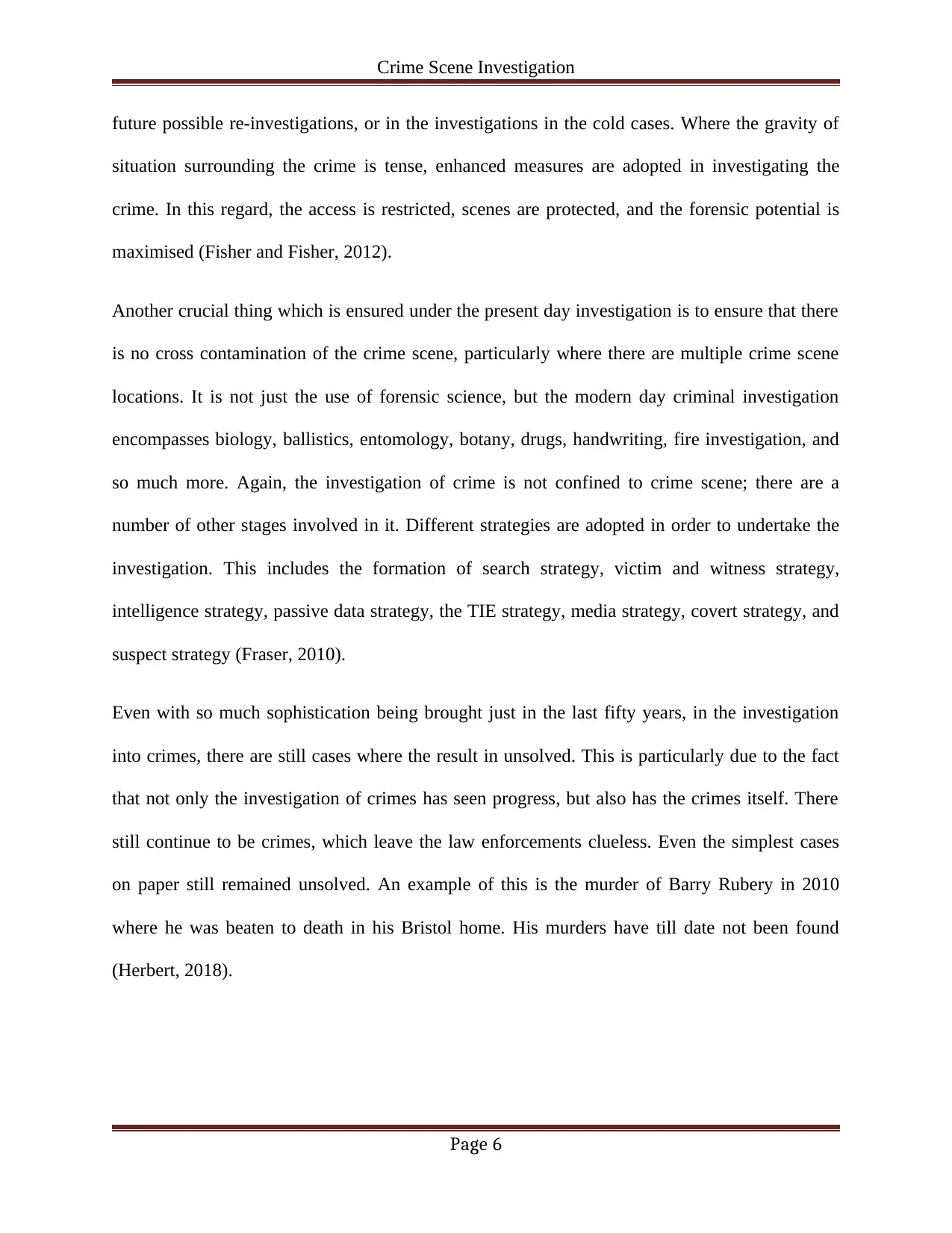
Crime Scene Investigation
future possible re-investigations, or in the investigations in the cold cases. Where the gravity of
situation surrounding the crime is tense, enhanced measures are adopted in investigating the
crime. In this regard, the access is restricted, scenes are protected, and the forensic potential is
maximised (Fisher and Fisher, 2012).
Another crucial thing which is ensured under the present day investigation is to ensure that there
is no cross contamination of the crime scene, particularly where there are multiple crime scene
locations. It is not just the use of forensic science, but the modern day criminal investigation
encompasses biology, ballistics, entomology, botany, drugs, handwriting, fire investigation, and
so much more. Again, the investigation of crime is not confined to crime scene; there are a
number of other stages involved in it. Different strategies are adopted in order to undertake the
investigation. This includes the formation of search strategy, victim and witness strategy,
intelligence strategy, passive data strategy, the TIE strategy, media strategy, covert strategy, and
suspect strategy (Fraser, 2010).
Even with so much sophistication being brought just in the last fifty years, in the investigation
into crimes, there are still cases where the result in unsolved. This is particularly due to the fact
that not only the investigation of crimes has seen progress, but also has the crimes itself. There
still continue to be crimes, which leave the law enforcements clueless. Even the simplest cases
on paper still remained unsolved. An example of this is the murder of Barry Rubery in 2010
where he was beaten to death in his Bristol home. His murders have till date not been found
(Herbert, 2018).
Page 6
future possible re-investigations, or in the investigations in the cold cases. Where the gravity of
situation surrounding the crime is tense, enhanced measures are adopted in investigating the
crime. In this regard, the access is restricted, scenes are protected, and the forensic potential is
maximised (Fisher and Fisher, 2012).
Another crucial thing which is ensured under the present day investigation is to ensure that there
is no cross contamination of the crime scene, particularly where there are multiple crime scene
locations. It is not just the use of forensic science, but the modern day criminal investigation
encompasses biology, ballistics, entomology, botany, drugs, handwriting, fire investigation, and
so much more. Again, the investigation of crime is not confined to crime scene; there are a
number of other stages involved in it. Different strategies are adopted in order to undertake the
investigation. This includes the formation of search strategy, victim and witness strategy,
intelligence strategy, passive data strategy, the TIE strategy, media strategy, covert strategy, and
suspect strategy (Fraser, 2010).
Even with so much sophistication being brought just in the last fifty years, in the investigation
into crimes, there are still cases where the result in unsolved. This is particularly due to the fact
that not only the investigation of crimes has seen progress, but also has the crimes itself. There
still continue to be crimes, which leave the law enforcements clueless. Even the simplest cases
on paper still remained unsolved. An example of this is the murder of Barry Rubery in 2010
where he was beaten to death in his Bristol home. His murders have till date not been found
(Herbert, 2018).
Page 6
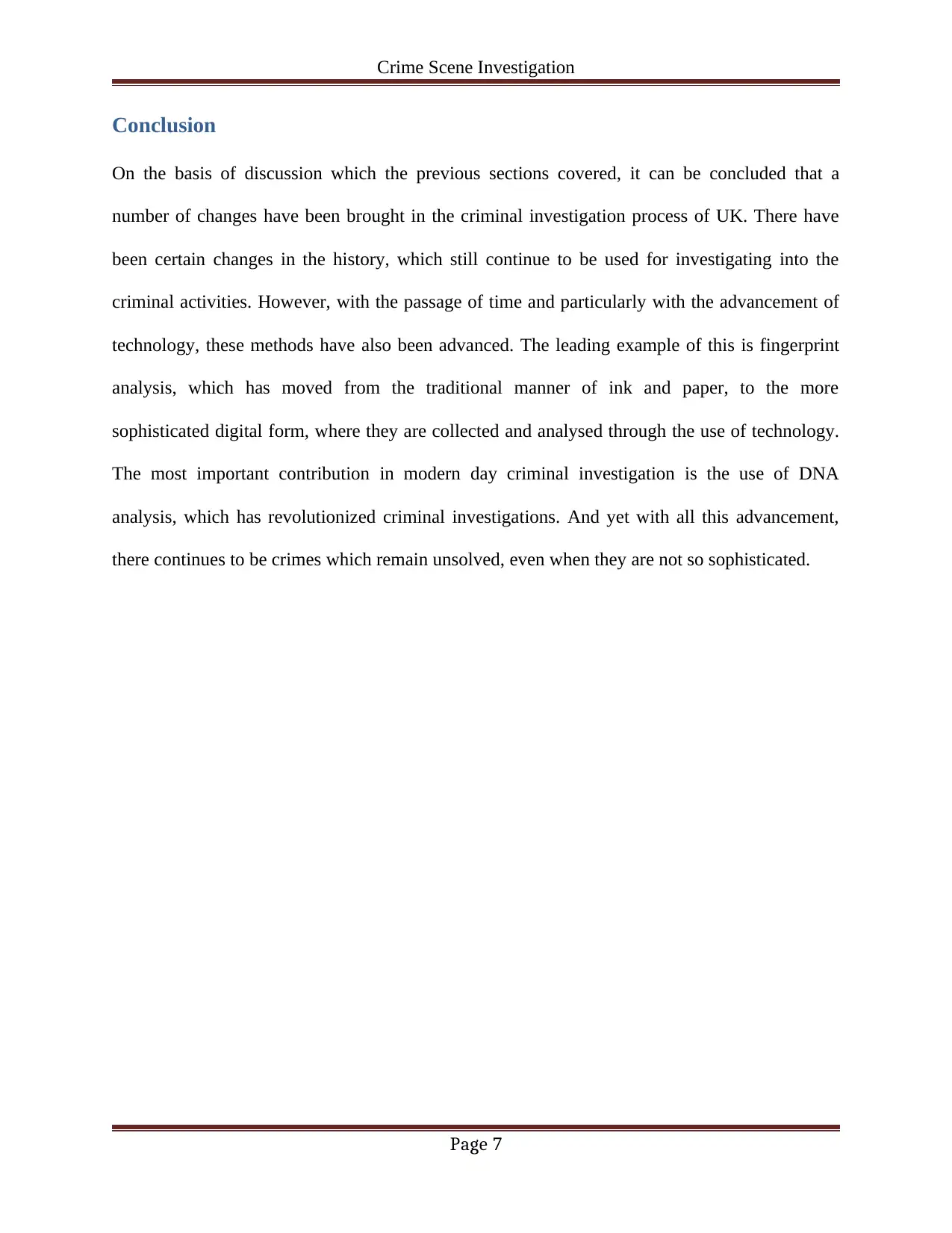
Crime Scene Investigation
Conclusion
On the basis of discussion which the previous sections covered, it can be concluded that a
number of changes have been brought in the criminal investigation process of UK. There have
been certain changes in the history, which still continue to be used for investigating into the
criminal activities. However, with the passage of time and particularly with the advancement of
technology, these methods have also been advanced. The leading example of this is fingerprint
analysis, which has moved from the traditional manner of ink and paper, to the more
sophisticated digital form, where they are collected and analysed through the use of technology.
The most important contribution in modern day criminal investigation is the use of DNA
analysis, which has revolutionized criminal investigations. And yet with all this advancement,
there continues to be crimes which remain unsolved, even when they are not so sophisticated.
Page 7
Conclusion
On the basis of discussion which the previous sections covered, it can be concluded that a
number of changes have been brought in the criminal investigation process of UK. There have
been certain changes in the history, which still continue to be used for investigating into the
criminal activities. However, with the passage of time and particularly with the advancement of
technology, these methods have also been advanced. The leading example of this is fingerprint
analysis, which has moved from the traditional manner of ink and paper, to the more
sophisticated digital form, where they are collected and analysed through the use of technology.
The most important contribution in modern day criminal investigation is the use of DNA
analysis, which has revolutionized criminal investigations. And yet with all this advancement,
there continues to be crimes which remain unsolved, even when they are not so sophisticated.
Page 7
Paraphrase This Document
Need a fresh take? Get an instant paraphrase of this document with our AI Paraphraser
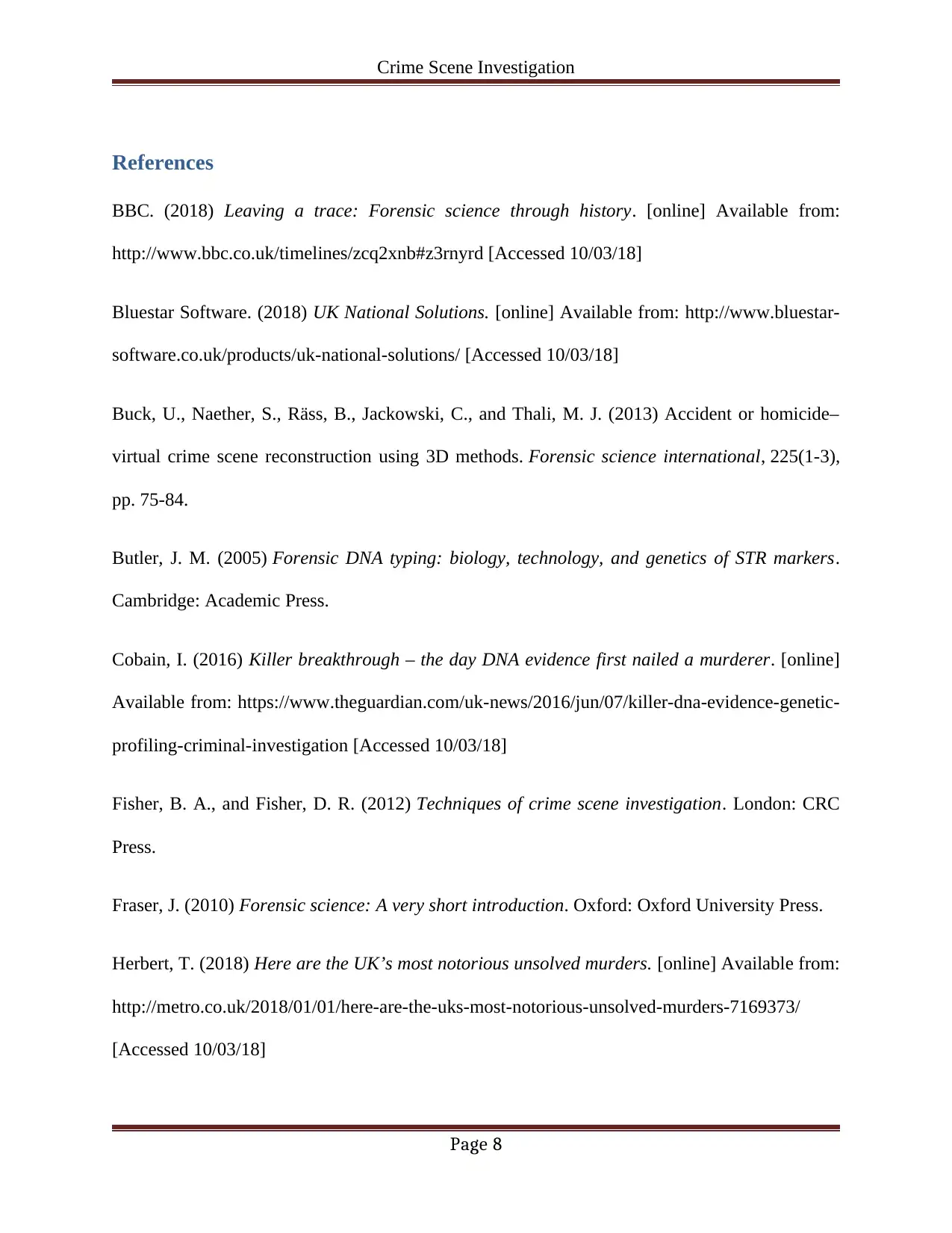
Crime Scene Investigation
References
BBC. (2018) Leaving a trace: Forensic science through history. [online] Available from:
http://www.bbc.co.uk/timelines/zcq2xnb#z3rnyrd [Accessed 10/03/18]
Bluestar Software. (2018) UK National Solutions. [online] Available from: http://www.bluestar-
software.co.uk/products/uk-national-solutions/ [Accessed 10/03/18]
Buck, U., Naether, S., Räss, B., Jackowski, C., and Thali, M. J. (2013) Accident or homicide–
virtual crime scene reconstruction using 3D methods. Forensic science international, 225(1-3),
pp. 75-84.
Butler, J. M. (2005) Forensic DNA typing: biology, technology, and genetics of STR markers.
Cambridge: Academic Press.
Cobain, I. (2016) Killer breakthrough – the day DNA evidence first nailed a murderer. [online]
Available from: https://www.theguardian.com/uk-news/2016/jun/07/killer-dna-evidence-genetic-
profiling-criminal-investigation [Accessed 10/03/18]
Fisher, B. A., and Fisher, D. R. (2012) Techniques of crime scene investigation. London: CRC
Press.
Fraser, J. (2010) Forensic science: A very short introduction. Oxford: Oxford University Press.
Herbert, T. (2018) Here are the UK’s most notorious unsolved murders. [online] Available from:
http://metro.co.uk/2018/01/01/here-are-the-uks-most-notorious-unsolved-murders-7169373/
[Accessed 10/03/18]
Page 8
References
BBC. (2018) Leaving a trace: Forensic science through history. [online] Available from:
http://www.bbc.co.uk/timelines/zcq2xnb#z3rnyrd [Accessed 10/03/18]
Bluestar Software. (2018) UK National Solutions. [online] Available from: http://www.bluestar-
software.co.uk/products/uk-national-solutions/ [Accessed 10/03/18]
Buck, U., Naether, S., Räss, B., Jackowski, C., and Thali, M. J. (2013) Accident or homicide–
virtual crime scene reconstruction using 3D methods. Forensic science international, 225(1-3),
pp. 75-84.
Butler, J. M. (2005) Forensic DNA typing: biology, technology, and genetics of STR markers.
Cambridge: Academic Press.
Cobain, I. (2016) Killer breakthrough – the day DNA evidence first nailed a murderer. [online]
Available from: https://www.theguardian.com/uk-news/2016/jun/07/killer-dna-evidence-genetic-
profiling-criminal-investigation [Accessed 10/03/18]
Fisher, B. A., and Fisher, D. R. (2012) Techniques of crime scene investigation. London: CRC
Press.
Fraser, J. (2010) Forensic science: A very short introduction. Oxford: Oxford University Press.
Herbert, T. (2018) Here are the UK’s most notorious unsolved murders. [online] Available from:
http://metro.co.uk/2018/01/01/here-are-the-uks-most-notorious-unsolved-murders-7169373/
[Accessed 10/03/18]
Page 8
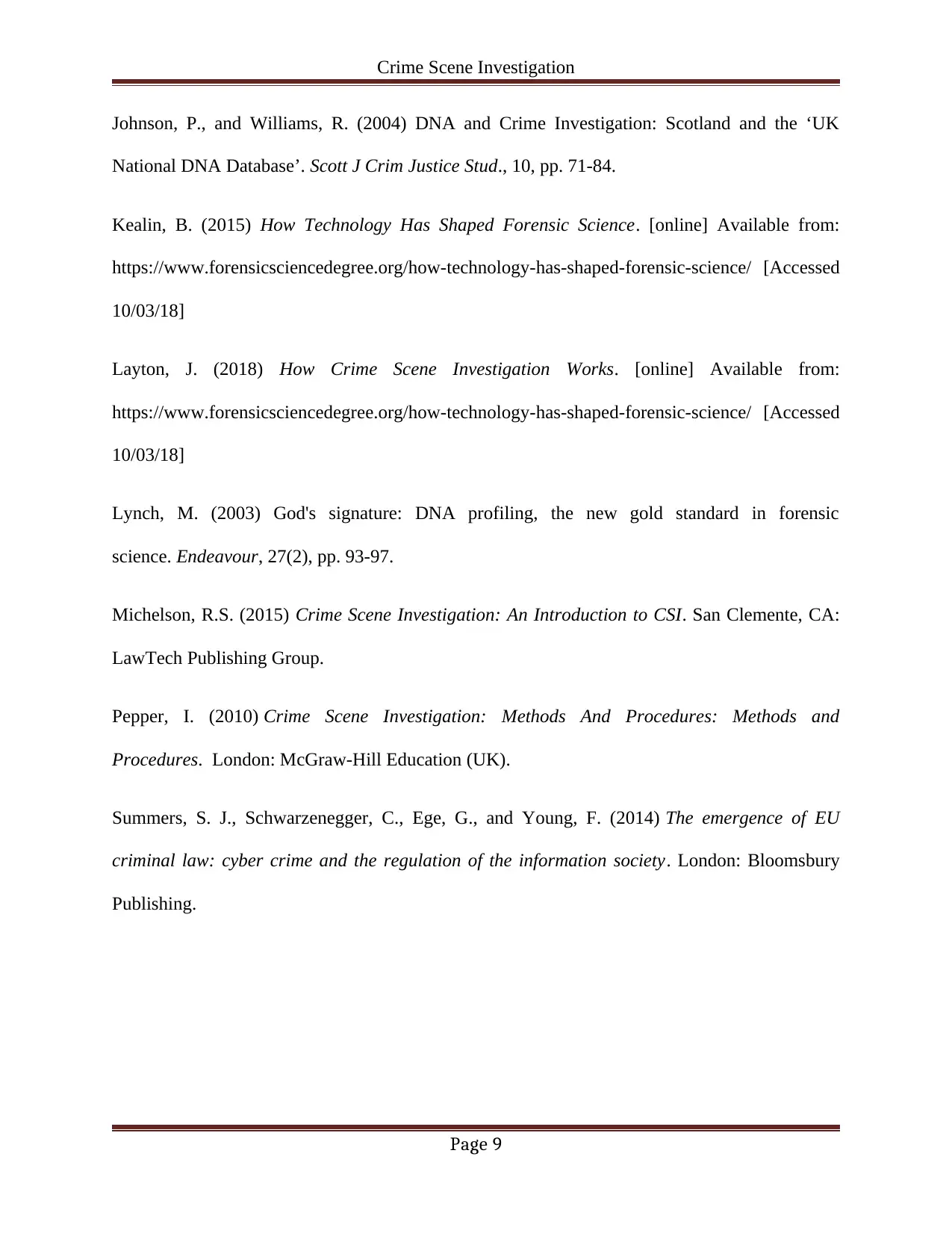
Crime Scene Investigation
Johnson, P., and Williams, R. (2004) DNA and Crime Investigation: Scotland and the ‘UK
National DNA Database’. Scott J Crim Justice Stud., 10, pp. 71-84.
Kealin, B. (2015) How Technology Has Shaped Forensic Science. [online] Available from:
https://www.forensicsciencedegree.org/how-technology-has-shaped-forensic-science/ [Accessed
10/03/18]
Layton, J. (2018) How Crime Scene Investigation Works. [online] Available from:
https://www.forensicsciencedegree.org/how-technology-has-shaped-forensic-science/ [Accessed
10/03/18]
Lynch, M. (2003) God's signature: DNA profiling, the new gold standard in forensic
science. Endeavour, 27(2), pp. 93-97.
Michelson, R.S. (2015) Crime Scene Investigation: An Introduction to CSI. San Clemente, CA:
LawTech Publishing Group.
Pepper, I. (2010) Crime Scene Investigation: Methods And Procedures: Methods and
Procedures. London: McGraw-Hill Education (UK).
Summers, S. J., Schwarzenegger, C., Ege, G., and Young, F. (2014) The emergence of EU
criminal law: cyber crime and the regulation of the information society. London: Bloomsbury
Publishing.
Page 9
Johnson, P., and Williams, R. (2004) DNA and Crime Investigation: Scotland and the ‘UK
National DNA Database’. Scott J Crim Justice Stud., 10, pp. 71-84.
Kealin, B. (2015) How Technology Has Shaped Forensic Science. [online] Available from:
https://www.forensicsciencedegree.org/how-technology-has-shaped-forensic-science/ [Accessed
10/03/18]
Layton, J. (2018) How Crime Scene Investigation Works. [online] Available from:
https://www.forensicsciencedegree.org/how-technology-has-shaped-forensic-science/ [Accessed
10/03/18]
Lynch, M. (2003) God's signature: DNA profiling, the new gold standard in forensic
science. Endeavour, 27(2), pp. 93-97.
Michelson, R.S. (2015) Crime Scene Investigation: An Introduction to CSI. San Clemente, CA:
LawTech Publishing Group.
Pepper, I. (2010) Crime Scene Investigation: Methods And Procedures: Methods and
Procedures. London: McGraw-Hill Education (UK).
Summers, S. J., Schwarzenegger, C., Ege, G., and Young, F. (2014) The emergence of EU
criminal law: cyber crime and the regulation of the information society. London: Bloomsbury
Publishing.
Page 9
1 out of 9
Related Documents
Your All-in-One AI-Powered Toolkit for Academic Success.
+13062052269
info@desklib.com
Available 24*7 on WhatsApp / Email
![[object Object]](/_next/static/media/star-bottom.7253800d.svg)
Unlock your academic potential
© 2024 | Zucol Services PVT LTD | All rights reserved.





